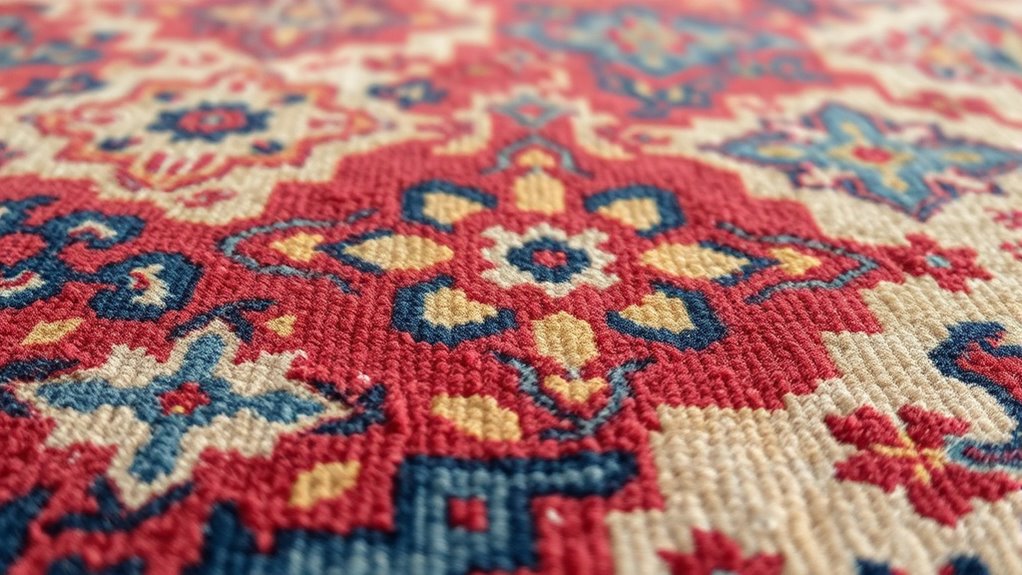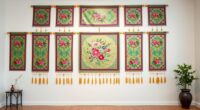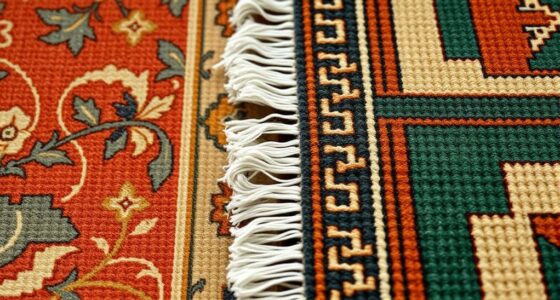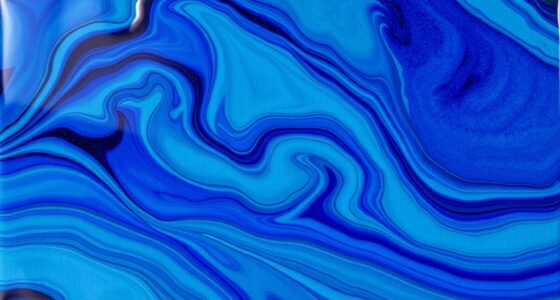To tell if an antique rug’s aged look is genuine patina or damage, observe the color, sheen, and texture. Authentic patina usually shows subtle, even fading, a soft sheen, and smooth areas that reflect natural aging. Damage, on the other hand, often appears as irregular patches, dull spots, fraying, or rough surfaces. Recognizing these signs can help you determine authenticity, and if you want to learn more, there’s much to discover about proper evaluation tools and techniques.
Key Takeaways
- Authentic patina shows even, subtle fading with rich color saturation and a gentle sheen, unlike irregular patches from damage.
- Patina feels soft and smooth, while damage often results in brittle, frayed, or rough fiber textures.
- Wear patterns like frayed edges and consistent center traffic indicate genuine aging; uneven or patchy areas suggest damage.
- Damage may cause irregular discoloration, holes, or unraveling, whereas patina develops gradually and uniformly over time.
- Signs of restoration or dye migration, such as uneven color or artificial brightness, point to damage or repair, not natural aging.
Understanding the Natural Aging Process of Rugs

Many antique rugs develop a unique character over time through the natural aging process. As your rug ages, you may notice fiber deterioration, which causes the fibers to become softer or more fragile. This is a normal part of aging and not necessarily a sign of damage. Similarly, dye fading occurs gradually, giving the rug a more muted, aged appearance. This process enhances the rug’s patina, often adding to its charm. Keep in mind that these changes happen slowly and uniformly, reflecting genuine wear rather than accidental damage. Recognizing these signs allows you to appreciate your rug’s history and character, and understanding the interpretation of symbols can help you better appreciate the story your rug tells.
Visual Characteristics of Authentic Patina
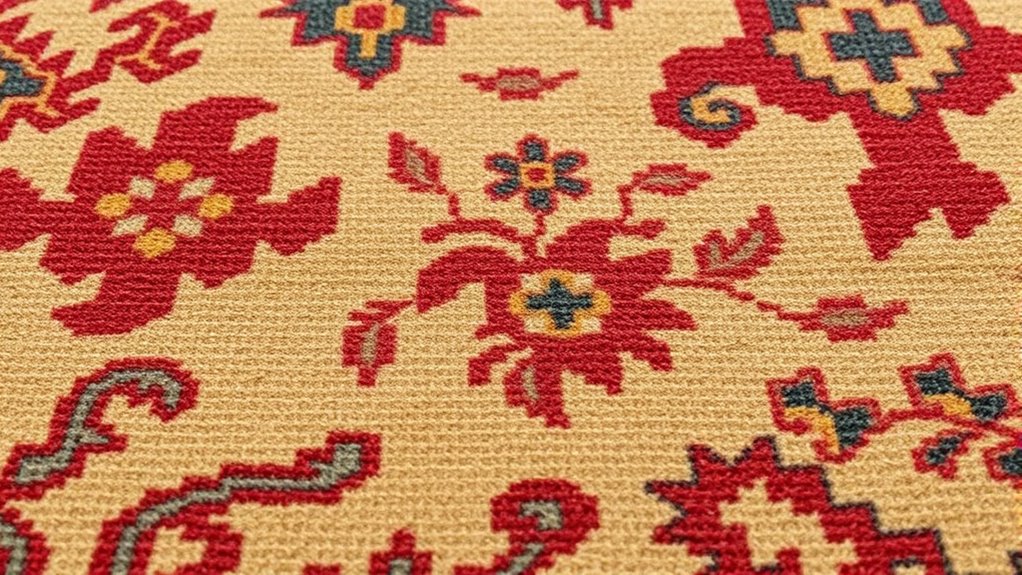
Authentic patina on antique rugs manifests as subtle variations in color and texture that develop naturally over time. These changes contribute to the vintage aesthetics you seek, reflecting the rug’s history. An artistic patina appears as uneven fading, softened details, and gentle sheen that enhance its character. Look for areas where colors blend softly or where the surface shows a delicate sheen, indicating genuine aging. The texture may also vary slightly, with some parts feeling smoother or more worn. This visual harmony distinguishes authentic patina from artificial effects or damage. To better understand, consider this table:
| Characteristic | Description | Indicator of Authenticity |
|---|---|---|
| Color variations | Blended, uneven tones | Natural aging |
| Surface sheen | Soft, gentle gloss | Authentic patina |
| Texture differences | Slightly worn, smooth areas | Genuine wear |
| Fading patterns | Irregular, subtle | Natural development |
| Overall harmony | Cohesive vintage look | Artistic patina |
Additionally, examining the auras associated with the rug’s history can provide insights into its spiritual and emotional significance, helping to identify authentic aging processes.
Common Types of Damage and Their Indicators
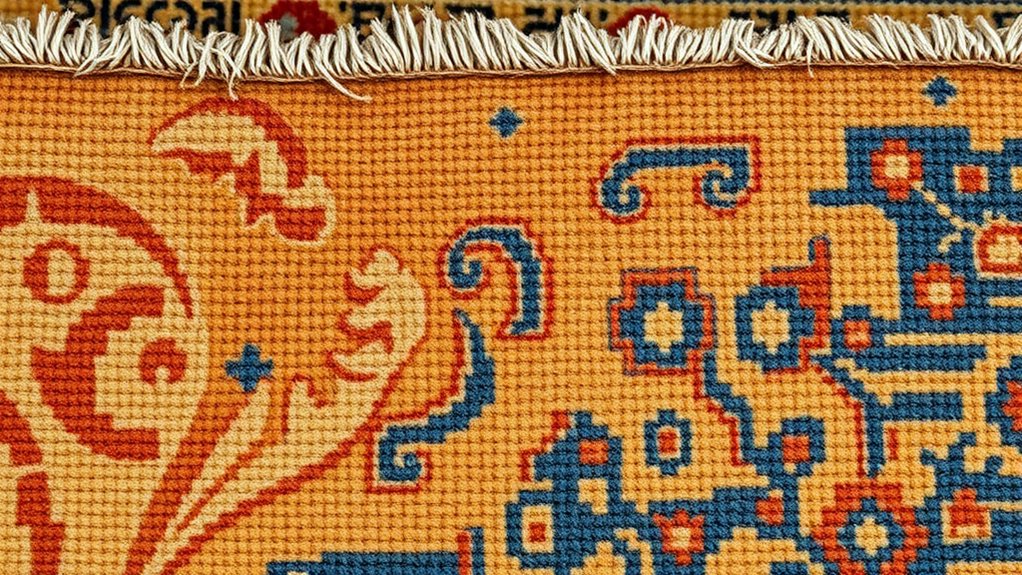
Damage on antique rugs often presents as visible irregularities that disrupt the rug’s original appearance. Look for frayed edges, where fibers unravel, signaling wear over time. Loose knots, which may cause areas to feel uneven or lumpy, indicate weakened construction. Tears or holes can appear suddenly or gradually enlarge, especially in high-traffic spots. Discoloration or stains often mark spills, but they can also result from prolonged exposure to sunlight or moisture. Additionally, areas with uneven pile height suggest heavy foot traffic or intentional trimming. These signs help you identify damage that affects rug value and authenticity. Recognizing these indicators allows you to assess whether a rug’s wear is due to age and use or if it’s been improperly repaired or damaged. Understanding the importance of authenticity helps preserve the value and integrity of antique rugs.
Analyzing Wear Patterns Across Different Areas
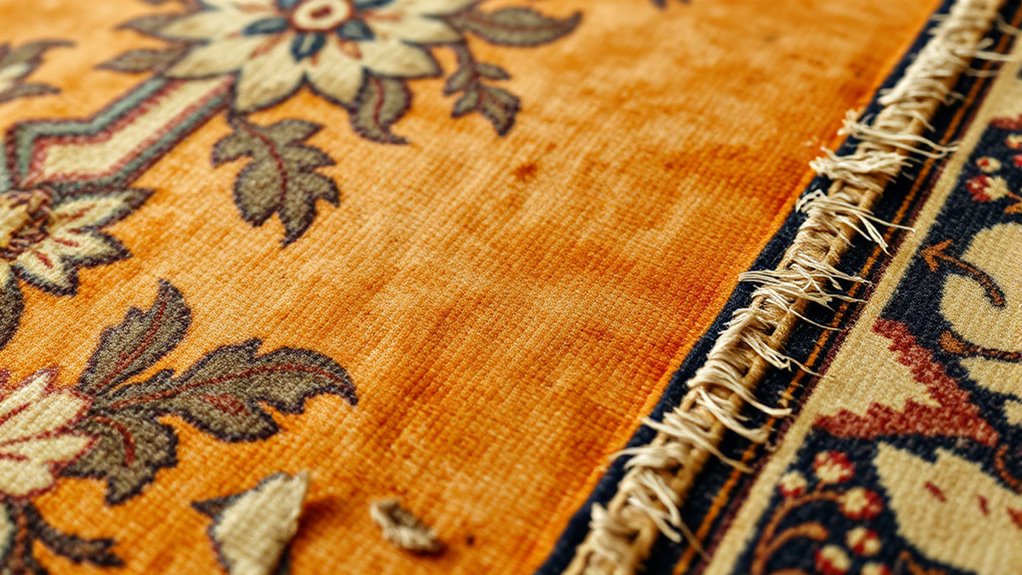
Examining how wear patterns appear in different areas of an antique rug can reveal valuable clues about its history and use. Fringe wear often indicates foot traffic or handling near the edges, showing if the rug was frequently used or moved. Areas with consistent wear, like the center, may suggest where people most often sat or walked. Knot density variations can also tell you about the rug’s construction and how it was used; higher knot density in certain sections might point to more intricate or valuable parts of the design, while thinner areas suggest less frequent contact. Additionally, wear pattern analysis can help distinguish between genuine patina resulting from age and damage caused by mishandling or environmental factors. By paying close attention to these patterns, you can identify authentic signs of aging versus superficial damage.
The Role of Colors and Sheen in Differentiating Patina From Damage
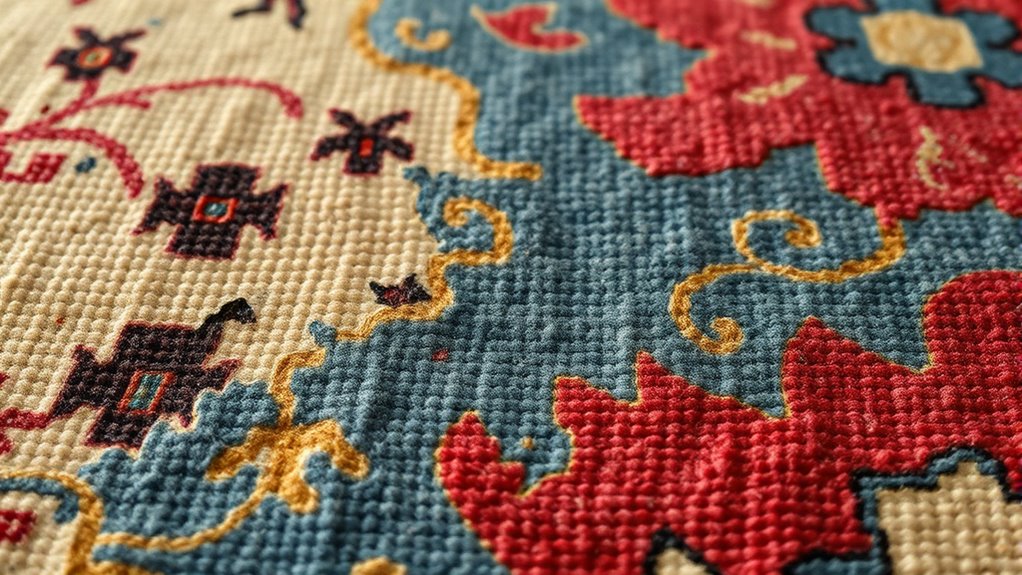
Colors and sheen are essential indicators when differentiating genuine patina from surface damage on antique rugs. Patina typically exhibits rich, even color saturation, reflecting age and authentic wear. Damage often causes irregular color patches or faded areas that lack uniformity. Sheen variation is also telling—patina maintains a subtle, natural gloss, whereas damage may create dull spots or shiny patches from surface abrasion or repairs. To distinguish between the two, look for:
- Consistent, deep color saturation across the rug
- Gentle, even sheen without abrupt changes
- Areas where sheen remains intact despite wear
- Irregular color patches indicating fading or staining
- Recognizing the dog-earing of fibers can also help identify authentic aging versus artificial distress.
Textural Clues: Surface Feel and Fiber Condition
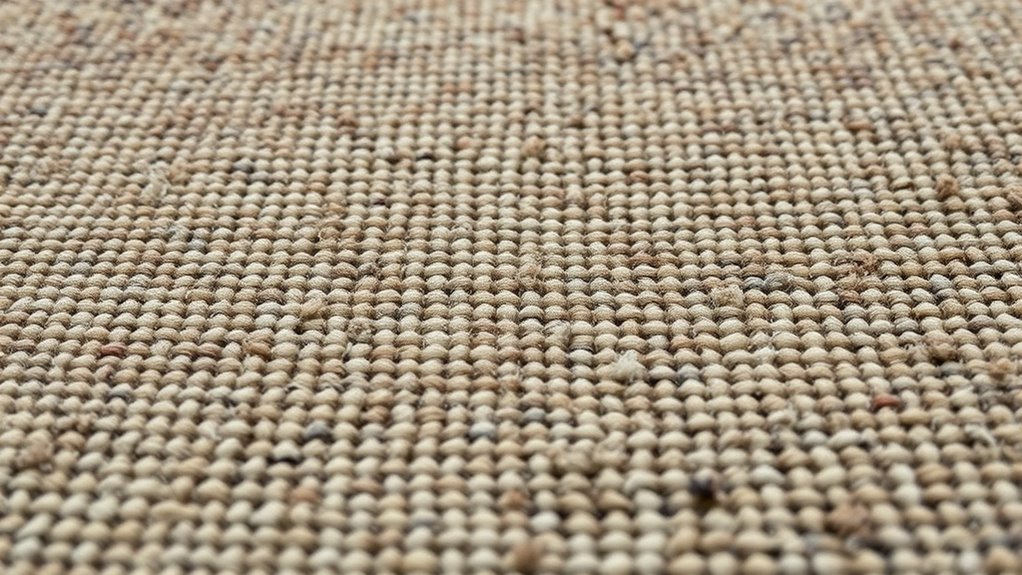
Since the surface feel and fiber condition can reveal a rug’s true age and authenticity, paying close attention to these tactile clues is essential. You’ll notice that authentic antique rugs often have a softer, more pliable fiber texture due to natural aging, while damage may cause fibers to feel brittle or rough. Surface smoothness can indicate wear from foot traffic, with worn areas feeling polished and silky, contrasting with rough patches from damage. Use this table to compare:
| Condition | Fiber Texture | Surface Feel |
|---|---|---|
| Patina | Soft, mellow fiber | Smooth, worn |
| Damage | Brittle, frayed fibers | Rough, irregular |
Historical Context and Its Influence on Wear and Patina
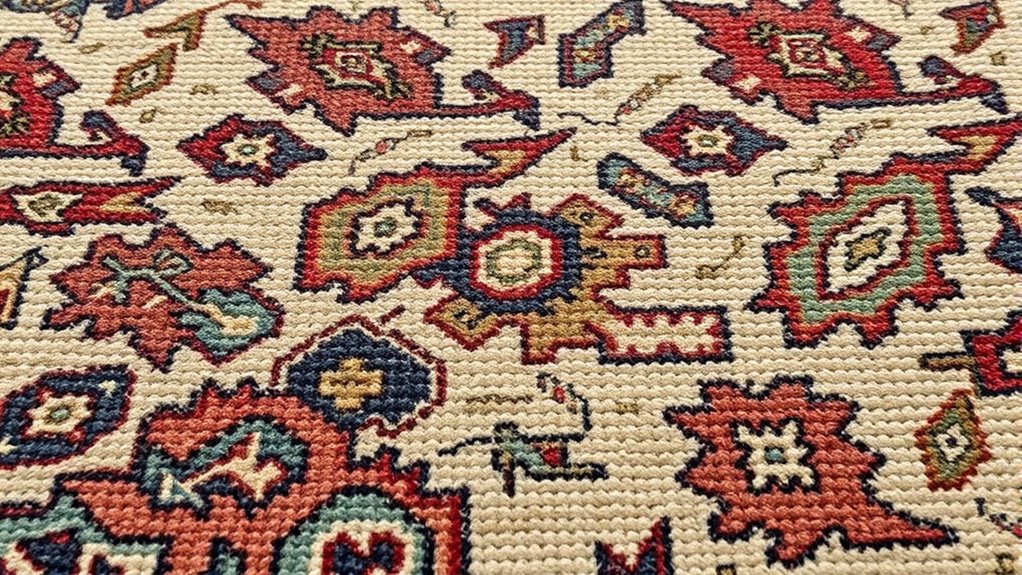
Understanding the historical context of an antique rug helps explain the variations in wear and patina you observe today. Cultural significance shaped how rugs were used and valued, influencing their exposure and aging. For example, rugs from bustling marketplaces saw more foot traffic, creating distinct wear patterns. The dye evolution also plays a role; earlier dyes may fade or develop unique patinas over time, reflecting regional techniques. Additionally, historical trade routes impacted fiber quality and repair practices, affecting wear patterns. The authenticity of a rug often correlates with its age and how it was handled over the centuries.
Techniques for Assessing Authenticity and Condition
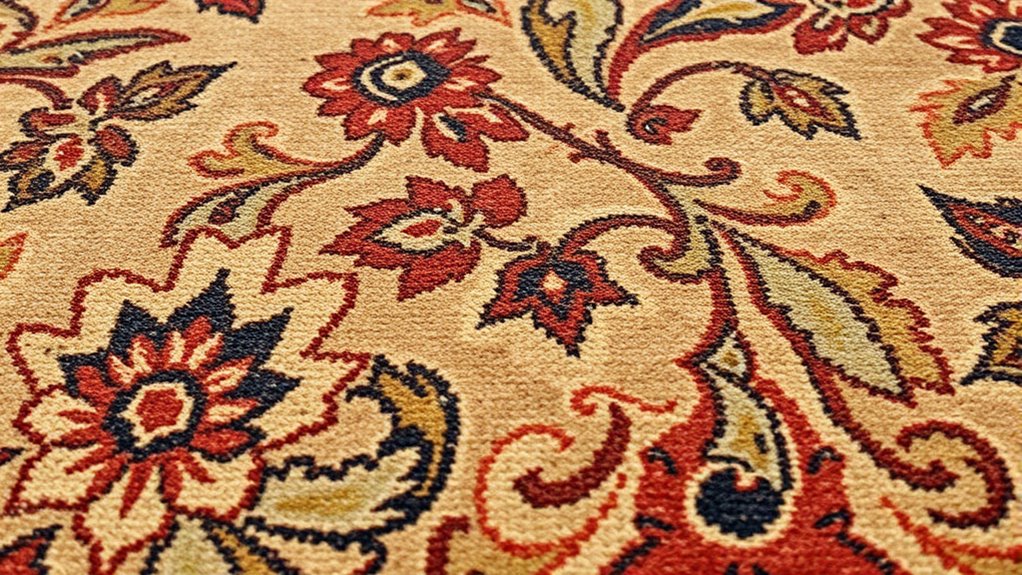
To accurately assess the authenticity and condition of an antique rug, you need to carefully examine specific indicators that reveal its origins and state of preservation. Look closely at the fibers for signs of deterioration, such as fraying, thinning, or brittleness, which signal age and wear. Check for dye bleeding, where colors may bleed or fade unevenly, indicating natural dyes and an authentic age. Use a magnifying glass to scrutinize the weave and knot density, helping distinguish genuine pieces from reproductions. Feel the rug’s surface for patina versus damage—authentic wear should feel smooth and consistent, while damage may feel rough or uneven. Additionally, understanding the wear patterns can provide insights into how the rug was used and cared for over time. Combining these visual and tactile assessments allows you to form a clearer picture of the rug’s history and condition.
When to Seek Professional Evaluation
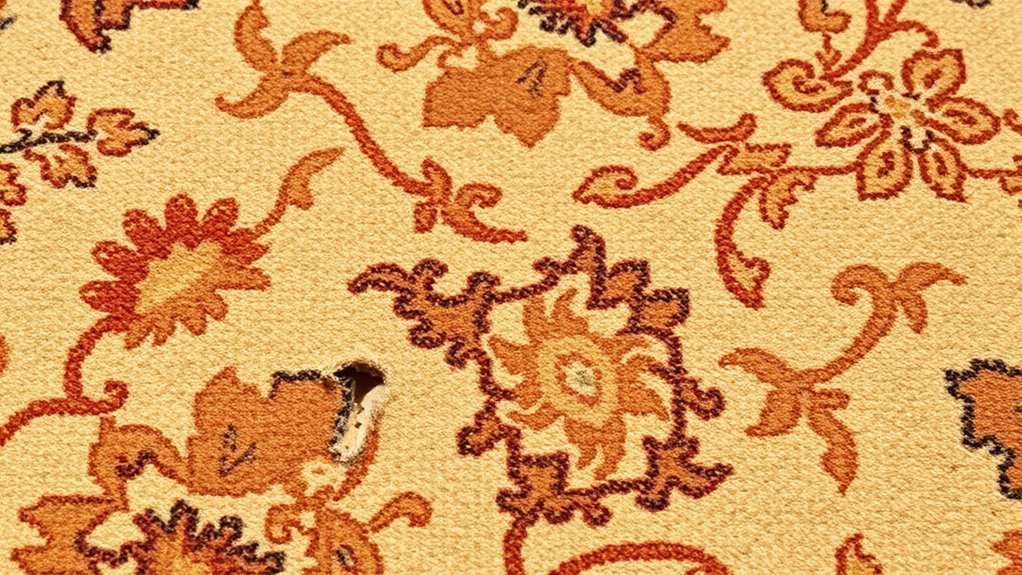
If you notice major color changes or unusual wear patterns on your rug, it’s a good idea to get a professional opinion. Suspected signs of restoration or repairs can also indicate underlying issues that need expert assessment. When in doubt, consulting a specialist guarantees your rug’s authenticity and condition are properly evaluated. Additionally, understanding damage and wear patterns can help determine whether the rug requires cleaning, restoration, or further preservation efforts.
Significant Color Changes
When you notice significant changes in your antique rug’s colors, it’s a clear sign that professional evaluation is needed. These changes could indicate underlying issues like color fading or dye migration, which can compromise the rug’s integrity. If colors appear uneven, washed out, or if you see areas with unexpected discoloration, it’s time to consult an expert. Additionally, understanding lifestyle factors such as environmental exposure can help in assessing the cause of color changes.
- Sudden or uneven color fading that doesn’t match normal wear
- Blotchy patches or areas with inconsistent hues
- Signs of dye migration, where colors bleed into each other
- Discoloration that seems unrelated to light exposure or age
Addressing these issues early can prevent further damage and help preserve your rug’s value. A professional can determine whether the color changes are part of patina or signs of damage needing intervention.
Unusual Wear Patterns
Unusual wear patterns on your antique rug can signal underlying problems that go beyond normal aging. You might notice areas where woven patterns are markedly more worn or flattened, indicating uneven foot traffic or damage. Changes in knot density, such as thinning or unraveling in specific sections, also suggest distress. These irregularities can point to hidden issues like insect damage, fabric deterioration, or improper restoration. If you see patches where the weave looks distorted or the pile appears abnormally thin, it’s time to seek professional evaluation. Experts can assess whether the wear is a sign of patina or damage, ensuring your rug’s integrity and value are preserved. Recognizing wear patterns can help you determine when expert advice is necessary. Addressing these issues early helps maintain your antique rug’s beauty and longevity.
Suspected Restoration Signs
Noticing signs of recent or inconsistent work on your antique rug suggests it’s time to consult a professional. Restoration markers, such as irregular stitching or new patches, can indicate recent repairs. Look for color inconsistencies that disrupt the rug’s natural patina, often revealing areas that have been altered. Other signs include overly uniform shading or areas that seem unnaturally bright or fresh compared to surrounding fibers. These clues may point to past restoration attempts that affect the rug’s authenticity and value. Being aware of these indicators helps you determine when expert evaluation is necessary. Recognizing subtle restoration markers ensures you preserve your rug’s integrity and make informed decisions about its care and valuation.
Frequently Asked Questions
How Can I Distinguish Between Genuine Patina and Intentional Aging Effects?
When trying to distinguish genuine patina from intentional aging effects, you focus on age indicators and authenticity clues. Look for natural variations in color, sheen, and texture that develop gradually over time, rather than uniform wear or artificial distressing. Authentic patina often shows subtle, uneven aging, while fake effects may appear too consistent or superficial. Your keen eye and knowledge of rug history help you identify the true signs of age.
What Are the Best Tools for Inspecting Rug Wear and Damage?
Imagine you’re detective uncovering hidden clues—your tools reveal secrets others miss. To inspect rug wear and damage, you should use magnifying glasses to closely examine fibers and weaving, spotting subtle signs of aging or repair. UV light scanners help detect repairs or dyes altered by time, exposing areas of damage or restoration. These tools empower you to distinguish authentic wear from artificial aging, ensuring you evaluate antique rugs with confidence and precision.
Can Cleaning Methods Affect the Appearance of Patina or Damage?
Cleaning methods can markedly impact the appearance of your antique rug, especially its aging look. A harsh cleaning process might remove dirt but also strip away the patina that adds character and value. Conversely, gentle cleaning preserves the rug’s natural wear and aged appearance, helping maintain its authentic charm. Always choose appropriate techniques to protect the rug’s surface and avoid unintended damage or loss of its unique aging features.
How Does Rug Size Influence Wear Patterns and Aging Signs?
Rug size plays a significant role in how wear patterns and aging signs develop over time. Larger rugs tend to show more widespread wear, especially in high-traffic areas, leading to more noticeable aging signs. Smaller rugs often experience concentrated wear points, making patterns of use more apparent. As you observe aging, consider how the size influences these wear patterns, helping you assess the rug’s history and usage more accurately.
Are There Specific Rug Types More Prone to Misinterpreted Damage?
You should know that certain rug types, like wool or silk, are more prone to being misinterpreted as damage due to age-related distortions and fiber deterioration. These delicate fibers naturally wear over time, creating patterns that can resemble stains or tears. Recognizing the difference involves examining the rug’s overall patina and texture, helping you avoid mistaking genuine aging signs for damage and preserving the rug’s authentic character.
Conclusion
Understanding the difference between patina and damage helps you appreciate your antique rug’s story. Like a well-worn book, authentic wear adds character, while damage signals issues. By examining colors, textures, and wear patterns carefully, you can spot the true age and condition of your rug. When in doubt, consult a professional—think of them as your rug’s personal historian. This knowledge guarantees you cherish your piece’s beauty and authenticity for years to come.
